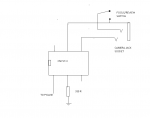bfgstew
Senior Member
I shall apologise first off for a lack of detail as I am at work and unable to offer photo's of circuit.
My problem is on an optocoupler circuit to fire my camera, it works fine with just the camera on, and OK when I add my flashgun onto the camera, the problem arises when I add my 90mm home made ringflash onto the camera, (the ringflash is fired by my flashgun and works perfectly OK, when off the circuit) now what happens is when the camera is triggered it causes my circuit to reset? Now the optocoupler is a CNY17-3, input onto pin1, ground on pin 2 with a 330 ohm resistor added, output is on pins 4 and 5, base is left floating, I have checked, double checked and even used a MEGA to test the tracks on the OUTPUT side of the circuit, all is fine, no dubious joints or tracks, so how can an isolated circuit cause my circuit to brownout / reset?
It know must be due to something on the ringflash, is it too much current, to higher voltage and causing a spike or transient voltage to fly around, and if so how can this be cured please.
As I said at the start, sorry for lack of detailed info, but this is so frustrating as I am so close to completing this project.
Edit, running 40X2 chip, off 12v wall-wart unit and voltage is regulated to 5v as per Rev-Ed directions, doesn't do this during any other operation in program, just when camera is fired with ringflash attached.
My problem is on an optocoupler circuit to fire my camera, it works fine with just the camera on, and OK when I add my flashgun onto the camera, the problem arises when I add my 90mm home made ringflash onto the camera, (the ringflash is fired by my flashgun and works perfectly OK, when off the circuit) now what happens is when the camera is triggered it causes my circuit to reset? Now the optocoupler is a CNY17-3, input onto pin1, ground on pin 2 with a 330 ohm resistor added, output is on pins 4 and 5, base is left floating, I have checked, double checked and even used a MEGA to test the tracks on the OUTPUT side of the circuit, all is fine, no dubious joints or tracks, so how can an isolated circuit cause my circuit to brownout / reset?
It know must be due to something on the ringflash, is it too much current, to higher voltage and causing a spike or transient voltage to fly around, and if so how can this be cured please.
As I said at the start, sorry for lack of detailed info, but this is so frustrating as I am so close to completing this project.
Edit, running 40X2 chip, off 12v wall-wart unit and voltage is regulated to 5v as per Rev-Ed directions, doesn't do this during any other operation in program, just when camera is fired with ringflash attached.

